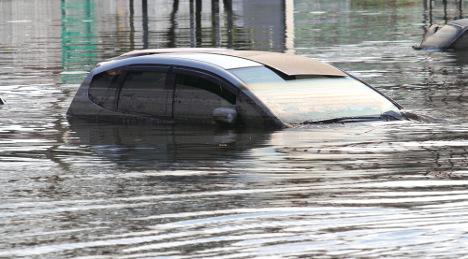7 warning signs of flood-damaged vehicles

With a host of rivers in places such as North Carolina cresting at record levels, Hurricane Matthew has floodwaters rising throughout the Southeast, wreaking havoc in communities, damaging homes, businesses and vehicles.
With the American Red Cross’ previous announcement that the this year’s flooding in Louisiana was the worst U.S. disaster since Hurricane Sandy in 2013, many property owners are concerned that Hurricane Matthew will further compound the issue of flood-damaged vehicles potentially going down the lanes or ending up in inventory.
“It’s important for used-car shoppers to know how to spot flood damage no matter where they live, because these cars can end up on a dealer lot anywhere, especially this year,” said Alliance Inspection Management (AiM) regional director Carl Sullivan, who has more than 32 years of vehicle inspection experience.
“A car that’s been in a flood, with the engine submerged for any length of time, will never be the same,” Sullivan continued.
Many states issue a flood or salvage title to a vehicle that has been submerged or flood-damaged, information which can be found on a vehicle history report.
However, some sellers may try to unload their vehicle before a flood or salvage title appears on a vehicle’s history report. To combat this possibility, Sullivan offered these warning signs to help identify flood damage in a vehicle:
• A musty odor in the vehicle, which may be from moldy carpeting or padding. If possible, pull up the carpeting to see how far water may have risen in the vehicle, and also if any moisture remains
• Mud in the seat belt tracks or seat belt tensioners
• Water or condensation in the headlights or taillights. Sullivan notes this could also be due to an accident, but water in these areas could also be a tip-off to flood-related problems
• Water in the spare tire well in a vehicle’s trunk. “If we see water in the spare tire well, it leads us to look a little further,” said Sullivan
• A sagging headliner in the interior, particularly on a late-model vehicle
• Look under the seats. “I found two fish under a back seat once,” said Sullivan, who was inspecting cars in Florida at the time. “That was a pretty sure sign the car had been flooded.”
• Corrosion in the vehicle’s undercarriage, such as on brake lines or around the fuel tank. When corrosion appears near the top of the springs or shock towers are corroded, these are signs of flood-related damage.
“A car’s engine, electronics, fuel system, airbags and brakes are all extremely susceptible to flood water,” Sullivan said. “It’s extremely important to find any water damage before you invest your money in a used car, and a professional inspection will find flood damage no matter how a seller tries to hide it.”
AiM and its team of 1200-plus full-time inspectors review vehicles throughout the U.S., providing detailed condition reports for clients ranging from consumers, dealers and auctions to manufacturers. AiM’s independent, 150-point inspection can identify problems on vehicles for buyers and sellers. The company has instructed its inspectors to pay particular attention to flood damage due to this year’s severe weather.
AiM also is a platinum sponsor of this year’s National Remarketing Conference/NAAA Convention, which is set for Nov. 16-18 at the Red Rock Resort and Casino in Las Vegas. It’s all part of Used Car Week that also includes the CPO Forum — America’s Used Car Conference, the SubPrime Forum and the Re3 Conference.
Used Car Week brings together dealers, auction executives, finance companies, service providers and other top industry experts for networking and more. A $200 early bird discount expires on Friday.
More details can be found at www.usedcarweek.biz.

 View The Latest Edition
View The Latest Edition

